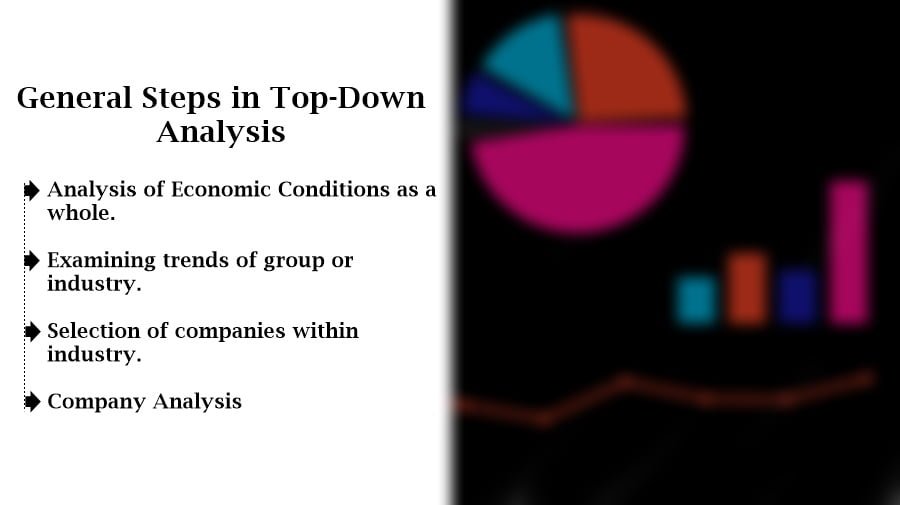
Table of Contents
Introduction
Fundamental Analysis is the second important market analysis. It provides traders and investors bigger picture of the market. The major goal of every analysis is to derive a prediction of the upcoming market movement and get profit from future price movement. It is the examination of present forces outside the market that have the potential to affect the present state of economy, industry group, and companies. A positive or negative news or anything effect the future movement of financial instrument accordingly. Although, there are number of methods and approaches used in fundamental analysis, top-down approach to fundamental analysis is used widely in market analysis. Learn more about basics of top-down analysis and steps included in this approach of fundamental analysis.

Points to remember
- Company level Fundamental Analysis contains scrutiny of financial data, its business plan, top quality management for the execution of business plan, and its competition with other companies.
- Industry level Fundamental Analysis may contain the scrutiny for the supply and demand forces for the product the company is offering.
- Fundamental Analysis for national economy might focuses on the examination of economic data to get the present and future growth of the economy.
- For complete Fundamental Analysis and for better prediction of prices for financial instrument, one must combine economics, industry, and company analysis to calculate current fair price of financial instrument and forecast future price of security.
- The concept of overvalued and undervalued arises when the fair value (price) is not equal to stock price, and price will be attracted to fair price.
General steps in Top-Down Approach to Fundamental Analysis
In fundamental analysis, all information is relative. Comparison is made between same groups i.e., companies against companies with same group, and industry group against other industry groups. For example, telecom companies will be compared to other telecom companies.

Top-Down Approach in market analysis seek to get the overall picture. Below are the steps a person can take in accomplishing top-down approach:
- Analysis of economic conditions as a whole: This step focuses on the scrutinization of GDP, Interest Rates, Unemployment ratios, and Inflation. In simple words, it focuses on the analysis of economy as a whole. This is because condition of economy plays an important role in price fluctuations of any stock, index, currency, and commodities. This is because when economy grow, most industry groups, and companies also grow. The same is true when companies face downfall, most sectors and industry groups suffer badly.
- Examining trends of group or industry: This step focuses on identifying specific sector, which an analyst thought, would perform well in future. In order to understand a potential of an industry group, multiple aspects of the industry group would be considered like the growth of the industry, market size of the industry, need of the industry to economy, and also the competitive prospect of the industry group. Although individual company is important, but stock prices are more influenced by its industry group. Due to this, it is sometime more important to be in the right industry group than in the right stock.
- Selection of companies within industry: After careful selection of industry, this task directs investors to look for the list of companies that are likely to perform well in future. In this step, the first task for fundamental analyst is to look for the present business, competition with in the same group, and also intentions for future. Companies with strong financial background (high revenue growth, low debts etc.) are preferred in this task. They also check the current leader of the company. Remember one thing, in business and trading success demands having an edge in the field. In fundamental analysis, one must look for company’s marketing strategy, its technology, and its market share. When an investor finds out an edge in the companies, they select it for further detailed analysis.
- Company Analysis: After accomplishing every task, it is the time for analyzing resources and capabilities within each company to select those that have clearly depicted abilities of creating and maintaining advantage in competition. In this step, analysis would be restricted to strong business plan of company with having strong management, and strong financial background. Business plan should be sensible. If the business is new, it should positively answer the questions of sensibility, feasibility, profitability, and having market. If the business is established, its direction should be clear and well defined, having a lead role in the market, and having strong and maintained leadership.
- Execution of business plan requires strong and well-disciplined management. Most of the most of the investor look for management for the analysis of company’s strength and weakness. Bad management sometime waste even the best well defined plans. Following things will be looked for better management: talent, having good track record, duration of their team as working together, delivery of their promises, and how best they work if problem comes.
- Final task in this step is the financial analysis of statement: Balance Sheets, account payable, accounts receivable, debt, cash flow, debt structure, market growth, market share, liabilities current and long term, assets long term and fixed, revenues, etc.
Concluding Remarks
Like technical analysis, there are number of strength and weakness adhered to Fundamental Analysis. There is no doubt that it is an important part of market analysis but there is an open debate whether to chose top-down approach or bottom up. Top-down approach is preferred by majority of the experienced investors. This is because it fulfills the purpose of Fundamental Analysis. Fundamental analysis clears for an investor long term point of view and this is the strength of Fundamental Analysis. However, in bottom up approach, we start with individual company’s stock, and the compare it with the its competitors which put an investor in confusion. Fundamental Analysis develops through understanding of the business and make him able to be familiar with key revenue and profit driver behind a market.
Frequently Asked Questions (FAQs)
How does top-down fundamental analysis differ from bottom-up analysis in terms of risk management?
Top-down analysis assesses macroeconomic risks and sector-specific risks before considering individual stock risks, potentially providing a broader risk perspective. In contrast, bottom-up analysis focuses on the financial health and performance of individual companies, potentially overlooking broader economic or sector-specific risks.
How do you incorporate geopolitical risks into a top-down fundamental analysis strategy?
Geopolitical risks are assessed by evaluating how international relations, political stability, trade policies, and global conflicts might impact overall economic conditions, specific sectors, and ultimately, individual companies. This analysis helps in identifying potential market disruptions or opportunities.
What are the limitations of relying solely on top-down fundamental analysis for investment decisions?
Sole reliance on top-down analysis might overlook crucial company-specific details, such as management quality, competitive positioning, or unique growth opportunities. Additionally, broad economic trends might not always translate into sector or company performance as expected.
I’m Abdullah Shah, a content writer with three years of experience in crafting engaging and informative content. My background in market analysis complements my work, allowing me to create content that resonates with audiences. I’m also a seasoned practitioner in the forex and crypto markets, with a strong foundation and deep interest in finance. My passion for the financial world drives me to produce content that is both insightful and valuable for those interested in understanding market trends and financial strategies.





